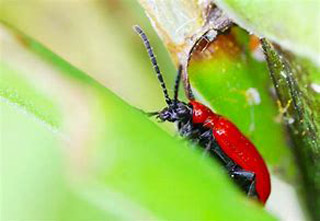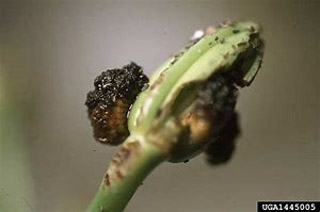
There’s a new pest I’ve noticed appearing in my garden over the past couple years. They are bright red little beetles with black bellies and antennas, called Scarlet Lily Leaf Beetles (Lilioceris lilii). Accidentally introduced into North America through Montreal, Quebec, in 1943 most likely with the shipment of bulbs from Europe. The insect was kept mostly contained, but in the Summer of 1992 was discovered in Massachusetts. And as of June 2012, they have appeared in all of New England and throughout New York. The beetles are predominantly found in moist, cool environments but have been spreading in further reaching regions. Some believe that the spread is due to gardeners sharing bulbs and flowers.
Life Span And Breeding
The Scarlet Lily Leaf Beetle lives and breeds on True Lilies and fritillaries causing quite a bit of distress; eating away at the stems, leaves, buds, and flowers. The most visible sign that the beetles are present are unattractive, brown sticky piles covered in fecal shields. These piles are the larvae of the beetles and are quite ferocious in their consumption. The damage first appears as chew holes and rapidly progresses to the blackening and complete loss of leaves with only stems left behind.
Invasion usually occurs in Spring along with the emergence of plants. The beetles overwinter in the soil and start laying their eggs on the underside of leaves hidden along the rib. The eggs appear in varying colors of browns, yellow, and orange taking around two weeks to hatch. Once hatched the eggs give way to the insatiable larvae. The best time to keep the beetles in check is during their early reproduction days, before the larvae emerge. These larvae cause the most damage, hundreds hatch at one time and start devouring underneath the leaves and then working their way up the rest of the plant. Once larvae are well fed, around 16-24 days, they then burrow in the ground to pupate in a cocoon of soil. In about 20 days they emerge as adults and continue to feed until winter, it’s possible for more than one cycle to occur in a year.

How to Control the Lily Leaf Beetle
The most promising means of destroying the spread of the invasive Lily Leaf Beetle seems to be a biological method, introducing natural predators. Although in America there are no natural predators present, in Europe the beetle is kept under control from various parasitoids. Researchers are proposing the introduction of the Ant Wasp to control the Lily Leaf Beetle population. But, that takes years of research and assurance that the introduction of the parasitoid does not destroy other creatures in the environment negatively.
The first step to resolve the Beetle’s destruction in your own garden is to destroy egg masses by handpicking, this also involves destroying the adult beetles and larvae as well. Pick and crush any eggs, adults, and larvae and drop into hot soapy water at least twice a week. It is important to inspect stems and leaves from all angles, and if there are none present but you assume they are there dig a little into the soil around the lily and there you may find them since they live a span of their life under the earth. Handpicking involves constant vigilance, it is important to remove any dead from the garden and to not leave any remains behind.
Another solution is to use organic sprays to control these hungry, destructive little beasts. Neem, an organic compound, will repel beetles and larvae and must be applied every 5 to 7 days after hatching. It’s important to remember that the spray should be heavy and complete, covering every inch of the plant. Spinosad is another solution, an insecticide made from soil bacteria, it is effective if applied weekly. The end of Spring and the beginning of Summer is when you’ll need to be attentive and persistent. Make sure to spray in the evening when bees are not foraging, as bees are an essential asset to any garden.
It does take a bit of love and dedication to be a Gardener, but to me it is well worth the effort. Gardening is a challenge where I can learn something new everyday, it’s an incredible hobby with nonstop rewards.







